| 释义 |
Theta FunctionThe theta functions are the elliptic analogs of the Exponential Function, and may be used to express the Jacobi EllipticFunctions. Let  be a constant Complex Number with be a constant Complex Number with  . Define the Nome . Define the Nome
 | (1) |
 | (2) |
 is a complete Elliptic Integral of the First Kind, is a complete Elliptic Integral of the First Kind,  is the Modulus, and is the Modulus, and  is the complementary Modulus. Then the theta functions are, inthe Notation of Whittaker and Watson, is the complementary Modulus. Then the theta functions are, inthe Notation of Whittaker and Watson,
Written in terms of  , ,
These functions are sometimes denoted  or or  , and a number of indexing conventions have been used. For asummary of these notations, see Whittaker and Watson (1990). The theta functions are quasidoubly periodic, as illustratedin the following table. , and a number of indexing conventions have been used. For asummary of these notations, see Whittaker and Watson (1990). The theta functions are quasidoubly periodic, as illustratedin the following table.Here,
 | (9) |
 , ,
The theta functions can be written in terms of each other:
Any theta function of given arguments can be expressed in terms of any other two theta functions with the same arguments.
Define
 | (15) |
 | (16) |
 | (17) |
 | (18) |
 | (19) |
 in the last gives the special case in the last gives the special case
 | (20) |
The theta functions obey addition rules such as
 | (25) |
 gives a duplication Formula gives a duplication Formula
 | (26) |
The theta functions can be expressed as products instead of sums by
where
 | (35) |
The theta functions satisfy the Partial Differential Equation
 | (36) |
 . Ratios of the theta functions with . Ratios of the theta functions with  in the Denominator also satisfydifferential equations in the Denominator also satisfydifferential equations
 | (37) |
 | (38) |
 | (39) |
 | (40) |
 | (41) |
 in 1827 and are equivalent to in 1827 and are equivalent to
 | (42) |
The complete Elliptic Integrals of the First and SecondKinds can be expressed using theta functions. Let
 | (44) |
 | (45) |
 | (46) |
 | (47) |
 | (48) |
 | (49) |
 | (50) |
 | (51) |
 | (52) |
 | (53) |
 | (54) |
 | (55) |
 is the complete Elliptic Integral of the First Kind, is the complete Elliptic Integral of the First Kind,
 | (56) |
References
Abramowitz, M. and Stegun, C. A. (Eds.). Handbook of Mathematical Functions with Formulas, Graphs, and Mathematical Tables, 9th printing. New York: Dover, p. 577, 1972.Bellman, R. E. A Brief Introduction to Theta Functions. New York: Holt, Rinehart and Winston, 1961. Berndt, B. C. ``Theta-Functions and Modular Equations.'' Ch. 25 in Ramanujan's Notebooks, Part IV. New York: Springer-Verlag, pp. 138-244, 1994. Morse, P. M. and Feshbach, H. Methods of Theoretical Physics, Part I. New York: McGraw-Hill, pp. 430-432, 1953. Whittaker, E. T. and Watson, G. N. A Course in Modern Analysis, 4th ed. Cambridge, England: Cambridge University Press, 1990.
|
![]() be a constant Complex Number with
be a constant Complex Number with ![]() . Define the Nome
. Define the Nome




























